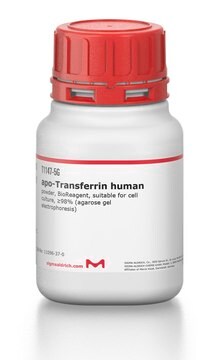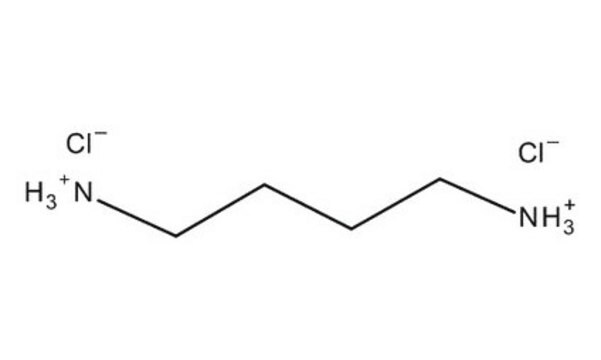P5780
Putrescine dihydrochloride
powder, BioReagent, suitable for cell culture
Sinónimos:
1,4-Butanediamine dihydrochloride, 1,4-Diaminobutane dihydrochloride, Tetramethylenediamine dihydrochloride
About This Item
Productos recomendados
biological source
microbial
synthetic
Quality Level
product line
BioReagent
assay
≥97% (TLC)
form
powder
technique(s)
cell culture | mammalian: suitable
mp
280 °C (dec.) (lit.)
solubility
H2O: 100 mg/mL
SMILES string
Cl[H].Cl[H].NCCCCN
InChI
1S/C4H12N2.2ClH/c5-3-1-2-4-6;;/h1-6H2;2*1H
InChI key
XXWCODXIQWIHQN-UHFFFAOYSA-N
¿Está buscando productos similares? Visita Guía de comparación de productos
General description
Application
Biochem/physiol Actions
signalword
Danger
hcodes
Hazard Classifications
Acute Tox. 2 Inhalation - Acute Tox. 3 Dermal - Acute Tox. 4 Oral - Eye Dam. 1 - Skin Corr. 1B
Storage Class
6.1A - Combustible acute toxic Cat. 1 and 2 / very toxic hazardous materials
wgk_germany
WGK 1
ppe
dust mask type N95 (US), Eyeshields, Gloves
Certificados de análisis (COA)
Busque Certificados de análisis (COA) introduciendo el número de lote del producto. Los números de lote se encuentran en la etiqueta del producto después de las palabras «Lot» o «Batch»
¿Ya tiene este producto?
Encuentre la documentación para los productos que ha comprado recientemente en la Biblioteca de documentos.
Los clientes también vieron
Nuestro equipo de científicos tiene experiencia en todas las áreas de investigación: Ciencias de la vida, Ciencia de los materiales, Síntesis química, Cromatografía, Analítica y muchas otras.
Póngase en contacto con el Servicio técnico















